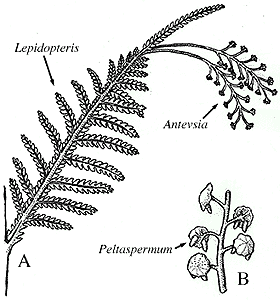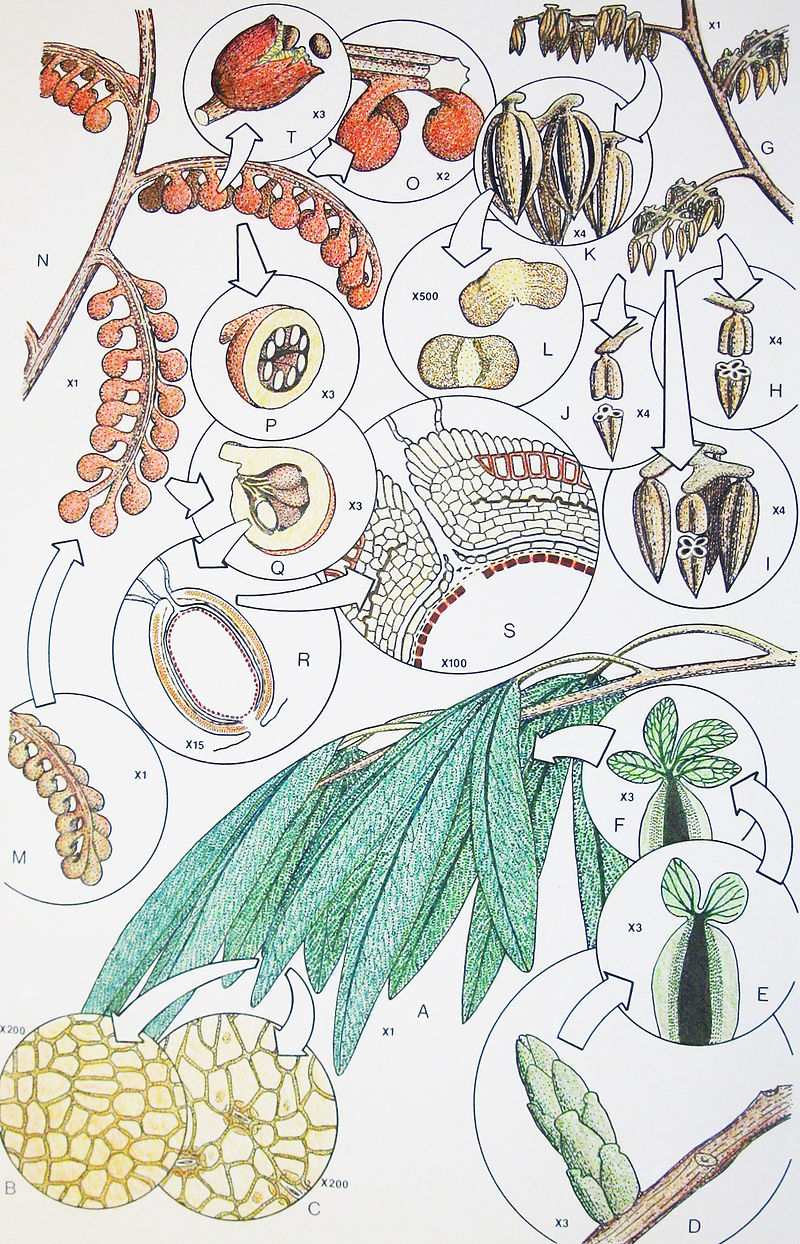Another element which is often not represented in paleoart are the Mesozoic “seed ferns”. This is an umbrella term for plants with different affinities united by the fact that they were seed plants with fern-like, often pinnate leaves.
Though ‘seed fern’ groups were rather abundant in the Paleozoic, quite a few grew among the Mesozoic vegetation. The most important of these groups are the Petriellales, Corystospermales (also called Umkomasiales), Peltaspermales, and Caytoniales. Aside from the Caytoniales, these groups are mostly limited to the Triassic.
These groups present quite some challenges in terms of paleoartistic representation: many of them are only know from disarticulated remains, and they left no extant representatives. For this reason, we often have little information about their general habit and appearance, and we can only rarely reconstruct how different organs fit together. However, some inferences can still be made, and some artistic licenses can be taken in representing them.
One of the most persistent memes about seed ferns is that they would have looked like ‘ferns’, especially like tree ferns. If this was probably true for some of the Palaeozoic groups (but definitely not all of them), it is definitely not true for many of the Mesozoic groups.
The Petriellales are a group with a more limited geographical and temporal extent, being limited to Gondwanan localities during the Triassic. However, it’s one of the groups for which we have the best information, since it has been possible to associate multiple organs in a whole-plant hypothesis. Petriellales were small, almost herbaceous plants with bifurcating leaves, probably growing as colonizers of open, disturbed habitats. A stunning reconstruction of these plants from the Fremouw formation of Antarctica by Frederik Spindler can be found in this manuscript (and the reference can be found on the Extinct Plant Paleoart Database).
The Corystospermales were also typical of Gondwana, and they lived between the Permian and the Triassic, with some persisting up to the Early Jurassic. The most typical characteristic of this groups are the leaves classified in the genus Dicroidium: these leaves were once or twice pinnate, with a very typical forked petiole. Seed-bearing structures (known as Umkomasia) were often brought on short shoots, while pollen-bearing structures (known as Pteruchus) consisted of a main axis bearing helically arranged microsporophylls with a slender stalk ending in a flattened head bearing many small pollen sacs on the underside. Although early reconstruction of Corystospermales saw them as tree-fern like plants, novel data suggest that at least some species were large trees.
The Peltaspermales are also found from the Permian to the Triassic, although they persisted in the Jurassic in Patagonia. This group is the most heterogeneous, and probably the least well understood. one of the best hypotheses for a ‘whole plant’ reconstruction is the Lepidopteris–Antevsia–Peltaspermum plant, which has been retrieved from many localities in Europe and Asia: this includes leaves which are bipinnate (that is, they are leaves with two order of rachises or structural parts and terminal ‘leaflets’), with pinnules attached to the main rachis as well as the rachillae. However, we have very little information on the general appearance of this plant, since stem and wood fossils are currently unknown.
The Caytoniales are a group that spans most of the Mesozoic, going from the Triassic to the Cretaceous. They are among the most famous of the Mesozoic seed ferns, since they have been involved in the elaborations of many hypotheses on the origin of the angiosperms. The female pats, Caytonia, are pinnate and have multiple seeds enclosed in leaf-like structures (cupules). It was originally described as an actual angiosperm, but later reinvestigations have clearly shown that pollen grains accessed the seeds within the ‘cupule’, instead of germinating on a stigma. The male parts (Caytonianthus) consist of an irregularly pinnate structure bearing four elongated fused pollen sacs. The leaves probably produced by the same plant that produced Caytonia are classified in the genus Sagenopteris. These are palmately compound leaves with each segment presenting a ‘midrib’ which then bifurcates to form lateral veins which irregulary fuse with each other. Although we do not have much information on the habit of the Caytonia plant, it has often been thought to have been a small tree.
I wish to thank Andres Elgorriaga for checking this post and helping with his deep knowledge of these groups.
References:
Bomfleur, B., Decombeix, A.L., Schwendemann, A.B., Escapa, I.H., Taylor, E.L., Taylor, T.N. and McLoughlin, S., 2014. Habit and ecology of the Petriellales, an unusual group of seed plants from the Triassic of Gondwana. International Journal of Plant Sciences, 175(9), pp.1062-1075.
Elgorriaga, A., Escapa, I.H. and Cúneo, N.R., 2019. Relictual Lepidopteris (Peltaspermales) from the Early Jurassic Cañadón Asfalto Formation, Patagonia, Argentina. International Journal of Plant Sciences, 180(6), pp.578-596.
Harris, T.M., 1964. The Yorkshire Jurassic Flora. II. Caytoniales, Cycadales & Pteridosperms. British Museum (Natural History).




Leave a comment